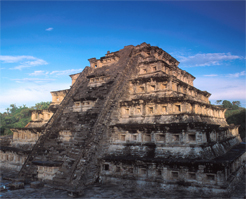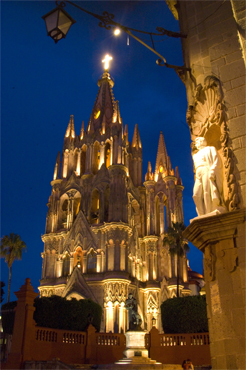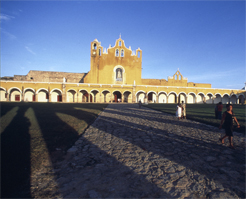Mexico Travel Guide



Telephone:
E:
The Country
Mexico is like a kaleidoscope, with lots of angles to its nature. No two people will see it alike. There are a lot of misconceptions about the country, and sometimes a dire lack of knowledge as well. If you come with an open mind and a positive attitude, you will be well rewarded. A sense of adventure helps too! Don’t expect anything to be like it is “back home” – it won’t. It is better to expect the unexpected. As the old popular song claims with good reason: “Como México no hay dos” – There’s no two like Mexico.
Area
This is a land of extreme diversity: the superficial glittering of fly-in fly-out tourist resorts coexists with awe-inspiring ancient cities, snow-covered volcanoes, slope-down pine forests, deserts, and balmy tropical beaches.
Mexico’s landscape and its people reflect the country’s extraordinary historical, cultural, artistic and predominantly Indian and Spanish heritage. Despite its considerable colonial legacy and rampant modernisation, there are still over 60 distinct indigenous peoples, each one of them speaking their own language and maintaining alive significant vestiges of their traditional lifestyles.
Official name: Estados Unidos Mexicanos (United States of Mexico)
Area: 1,972,550 sq. kms
Boundaries: U.S.A. to the north; Guatemala and Belize to the southeast
Coastline: Gulf of Mexico and Caribbean Sea to the east; Pacific Ocean to the west and to the south
Capital city: Ciudad de México (Mexico City)
Buses
Public intercity transportation in Mexico is provided almost exclusively by a large network of modern, air-conditioned motor coach fleets, connecting large and small towns throughout the country’s vast territory. First-class and de-luxe service is comfortable, reliable and punctual, with frequent departures to main destinations. Mexico’s highway network is Latin America’s largest and most modern one. Tickets for any given route can be booked and bought up to one month in advance.
Car Rental
All major international car rental companies have branch offices in Mexico City as well as in all state capitals and resorts. In addition, there are several local car rental companies providing good and reliable service. Car rental offices can usually also be found at larger hotels.
It is recommendable to check the cost of a car rental at client’s hometown, as it is often lower than the cost quoted by the same company’s Mexico branch.
Climate
Mexico is situated in the subtropical and temperate regions of North America. The topography of Mexico ranges from lowland coastal to high mountain areas. Mexico's geographic situation and diverse topography lead to variable climatic regimes.
For all practical purposes, climate in Mexico may be divided into the rainy season, from mid-May to mid-October, and the dry season comprising the rest of the year. The country’s landscape, mainly, suffers a radical change from one season to the other. The dry season’s sun-burnt, rugged mountain ranges under an impeccably blue, cloudless sky are converted into an unending chain of rolling green hills, under a sky of bizarre, sometimes tempestuous cloud formations during the rainy season
Within this frame, climate may vary from very hot and humid in the Yucatan Peninsula and the Chiapas jungles in the Southeast, to moderately warm and temperate in Central Mexico
Mexico City, with its over 7000 ft above-sea-level altitude, has a pleasant year-round climate, where temperatures tend to be quite extreme within the 24-hour range, with quite cool early-mornings and evenings, while from noon to the early afternoon hours temperatures range from warm to hot.
During the rainy season mornings tend to be clear and sunny, but are followed by copious, often stormy rainfall lasting about two hours by mid-afternoon. These precipitations may be repeated in the evening, and sometimes will last throughout the night.
Keeping in mind above characteristics, it may be said that travel to and through Mexico is not only possible but fully enjoyable throughout the year.
Cruise Ships
All necessary facilities and a well-oiled infrastructure are available for the reception of cruise ships at a large number of Mexican ports, mainly on the Pacific and Caribbean coasts. These include, from north to south, Ensenada, La Paz, Los Cabos, Mazatlán, Manzanillo, Puerto Vallarta, Ixtapa-Zihuatanejo, Acapulco and Huatulco, on the Pacific; and Cancún, Cozumel, Playa del Carmen, Majahual and Chetumal on the Caribbean.
Customs & Immigration
Mexico City and Cancun airports are the country’s entrance gates for virtually all overseas’ visitors. A valid passport and a Tourist Card –which can be obtained and filled out on the incoming aircraft- are the only documents required from citizens of most West European countries. Citizens of some East European countries or from other regions of the world will usually require a visa, issued by the nearest Mexican consulate. Prospective visitors are encouraged to obtain the pertaining information in advance.
IMPORTANT: Recent legislation allows citizens from countries normally requiring a visa to enter Mexico to dispense with that requirement if
• Their passport contains a valid U.S. visa, or
• They can prove to be legal and permanent residents of the U.S.A., Canada, Japan, the U.K. or of a Schengen Area country.
Immigration formalities are fast and uncomplicated. Visitors entering the country with a tourist card will get back a segment of it from the migration officer, with a seal showing the entry date. It is very important to keep this document in a safe place, as it must be delivered upon departure from Mexico.
Customs: passengers are allowed to carry all of their personal belongings, as well as photographic and video equipment, laptops and cellular phones; up to 25 cigarette packs and 3 litres of spirits are duty free.
Passengers’ luggage is inspected at random, by means of a semaphore: if passenger gets the red light, his/her luggage is inspected; otherwise he/she just walks out of customs hall.
Diving
There are several sites in Mexico which can be recommended for diving such as Los Cabos, Puerto Vallarta, and the area of the Caribbean Sea. But definitely the best area is the one in the Caribbean due to the large coral reefs barriers in the zone; as well as for those people that like to dive in caverns and cenotes. Top site in this area is Cozumel, and then Akumal, Puerto Aventuras, and Isla Mujeres. In order to quote any diving service it is necessary to have in advance accurate information from clients, as we need to know if they have or not a PADI license and on which level, etc. We suggest the following link: www.caveandtechnicaldivingmexico.com It belongs to our main diving purveyor in the area.
Dress
Dressing codes are quite casual throughout the country. Shorts or Bermudas should be avoided in the larger towns, however. Neckties and jackets are only required in some of the fanciest restaurants, for dinner, and this just in Mexico City, but not in smaller towns and even less at resorts.
Drink
All major restaurants and hotels have one hundred percent certified purified drinking water; and in almost all 4 and 5 star hotels bottled waters are provided in the rooms.
Eating Out - Food & Drink
Eating out in Mexico can be an exciting adventure. Seaside resorts like Cancun, Acapulco and Puerto Vallarta offer visitors a large choice of excellent five-star restaurants with a variety of specialities ranging from top seafood to typical Mexican, via exquisite exponents of Italian, Spanish, Thai, French, Japanese –you name it- cuisines. But also at a more modest level charming eateries may be found with one feature in common: a relaxed and cosy atmosphere plus, often, magnificent seascape views.
Fewer but equally tempting restaurants may be found in smaller or larger towns throughout the country, frequently specialized in that particular area’s regional cuisine. It must not be forgotten that Mexican cuisine has very recently been declared an Intangible World Heritage Site by UNESCO.
The greatest eating-out adventure, however, is to be sought after in Mexico City, which ranks among the great capitals of the world on account of the quantity, the quality and the variety of its restaurants. Speciality restaurants representing all imaginable cuisines of the world are to be found here, and a number of them are dedicated to the degustation of Mexican cuisine in its many varieties and styles, ranking from traditional country cooking to fancy and always creative nouvelle cuisine and fusion discoveries. Some of the city’s best restaurants are installed in old 16th c. Haciendas, an additional attraction to a dine-out adventure.
Electrical Current
Electric current throughout Mexico is conformed to 110 volts, 60 cycles, same as in the United States and Canada. Some electrical outlets at hotels are still of the two prong type. To get around this and enable guests to use a notebook computer with a three-prong electrical cord plug, it is suggested taking along a converter.
Guide Books
• Lonely Planet
• Frommers
• Rough Guides
• Fodors
Health & Insurance
All purveyors in Mexico such as hotels, guides, transportation companies, buses, and cars, have by law an insurance that covers any accident with clients.
Language
The official language in Mexico is Spanish, although over 60 indigenous languages and an even larger number of dialects are spoken in rural areas throughout the country. English is spoken and understood by a large number of Mexicans, particularly at hotels, restaurants, airports or any other area connected in one way or other with tourism.
Money
Unit currency in Mexico is the Mexican peso ($). Coins are in denominations of 20, 10, 5, 2 and 1 pesos, and of 0.50, 0.20, and 0.10 centavos (cents). Notes are in denominations of 20, 50, 100, 200, 500 and 1,000 pesos.
US dollars are accepted in Mexico, and prices can sometimes be found in dollars – not to be confused with the similar peso sign. The Euro is starting to be accepted in major cities or tourist centres, but it is usually valued at the same exchange rate than the US dollar.
Banks & Credit Cards
It is better to cash travellers’ cheques at a bank or at a Money Exchange Bureau, than at hotels or shops. However, for smaller amounts, the difference of exchange rate is negligible.
Even though Euros are beginning to be accepted as common currency, it is best to carry with you a reasonable amount of US dollar notes.
Major credit cards (American Express, Diners’ Club, Visa and MasterCard) are widely accepted throughout the country. Average exchange rate: US$ 1.00 equals Mex$12.00 (February 2011) but it is subject to fluctuations. Hotels and shops offer a less favourable rate than banks. Major credit cards like Visa and Mastercard are also accepted at automatic cashiers’.
Population
112,322,757 inhabitants (annual rate of growth: 1.4%).
Public Holidays
As of last year the same system as in the US has been applied moving the official holiday to next/prior Monday which is closest to the date.
Public days as follows (days –not dates- on the following list correspond to 2011 and it varies on each year):
• Saturday 1st January: New Year
• Thursday 6 January: Three Kings Day
• Saturday 5 February: Constitution’s DAy (moved to Monda February 7)
• Thursday 24 February: National Flag’s Day
• Monday 21 March: Benito Juárez Birthday
• Thursday 21 April: Holly Thursday
• Friday 22 April: Holly Friday
• Sunday 24 April: Holly Sunday
• Saturday 30 April: Children Day
• Sunday 1 May: Labor’s Day
• Wednesday 4 May: May Cultural Festivity
• Thursday 5 May: Puebla’s Battle
• Tuesday 10 May: Mother’s Day
• September (first week): Mariachis’ Day
• Thursday 1 September: President of Mexico presents its anual report to the Congress
• Friday 16 September: Independence Day
• Tuesday 1 November: All Saints Day
• Wednesday 2 November: Day of the Dead
• Sunday 20 November: Revolution’s Day (moved to Monday November 21)
• Monday 12 December: Our Lady of Guadalupe Day
• Saturday 24 December: Noche Buena
• Sunday 25 December: Christmas Day
• Saturday 31 December: New Year’s Eve
Mandatory Public Days (by law)
• Saturday January 1st (New Year)
• Monday February 7 (due to 5 February Constitution’s Dasy)
• Monday March 21 (due to March 5 Benito Juarez’ Birtday)
• Sunday May 1 (Labor’s Day)
• Friday September 16 (Independence day)
• Monday November 21 (due to November 20 Revolution’s Day)
• Sunday December 25 (Christmas Day)
2011 Long weekends (by law)
• Saturday 5 February to Moday February 7
• Saturday March 19 to Monday March 21
• Friday September 16 to Sunday September 18
• Saturday November 19 to Monday November 21
Railways
There is basically no railways system in Mexico with exception the Copper Canyon Chihuahua-Pacifico train (tourist attraction).
Taxis
All taxis in Mexico have an authorized, by the local government, meter nevertheless it is advisable to use the taxi service provided by the taxis’ stands at each hotel. Also the concierge or the captain at any restaurant can book a safe taxi.
Telephone Services
Check the price of long-distance telephone calls from hotels before making calls. They are expensive, and the hotel usually adds an extra charge. We recommend buying instead telephone cards ($100.00 pesos) for making your long distance calls from a public phone.
Time
Almost all the country is located in the (GMT-06:00) central time zone.
The states of Chihuahua, Sinaloa, and the city of La Paz are in the (GMT-07:00) time zone.
The states of Baja California and Baja California Sur are located in the (GMT-08h00) time zone.
Vaccinatons
Clínica Alemana Avda: 6 de Agosto No. 2821 2432155
Clínica del Sur Calle: 7 Obrajes & Avda.Siles 2784002
Airlines
Main Office Airport
Aerosur: 16 de Julio 1616 11th F. 2312244 2817281-2817685
Amazonas: Avda Saavedra 1649 2220648
American Airlines: Plaza Venezuela 1440 2392009 2810114-2810115
Lan Chile: Avda. 16 de Julio 1566 2358377 2811917-2121961
LAB: Avda. Camacho 1456-1460 2371020/24 2810369
TACA: Paseo del Prado 1479 2313111 2822244
TAM: Mercosur Heriberto Gutiérrez 2323 2443442
Varig: Mariscal Santa Cruz 1392 2314040 2811925
Embassies
Australia: Avda. Arce & Montevideo 2440459 08:30-13:30
UK: Avda. Arce 2732 2433424 09:00-12:00
USA: Avda. Arce 2780 2430251 08:00-17:00
Time
Bolivia is 4 hours behind GMT and it is not subscribed to daylight savings time.
Vaccinations
There are no vaccination requirements for visitors entering Mexico. Yellow fever and other infectious diseases have been virtually eradicated throughout the country.
Culture
Mexicans have had a talent for art and a love of bright colours since pre-Hispanic times. Today, Mexico is covered with murals and littered with museums and galleries of contemporary and historic art. For many visitors, this is one of the country’s highlights.
Architecture and the visual arts were present already in pre-Hispanic Mexico. The great archaeological sites of the past, which can be found practically throughout the country, from the mysterious city of Paquimé in the far north, to the magnificent ceremonial centres of the Maya in the southeast, bear witness of the cultural achievements of the multiple peoples who inhabited present-day Mexico. With the Spanish conquest, different art styles and concepts are imposed upon the indigenous people. It is the Catholic Church, eager to win the heathen souls to the Christian faith, who acts as patron for the development of all arts in that period.
Some of Mexico’s imposing convents and monasteries, its many exuberant baroque churches, are the silent witnesses of those days’ artistic creativity.
In the 20th c. Mexico produced an impressive amount of scientists and artists in all the fields of human creativity: plastic arts, architecture, music, literature, scenic arts and cinema. Names like those of the painters Diego Rivera, Frida Kahlo, Orozco, Siqueiros, Tamayo and Toledo, of Nobel Prize winners Octavio Paz, Mario Molina and Alfonso García, writers and poets like Carlos Fuentes and Jaime Sabines, actors like Cantinflas, María Félix or Dolores del Río, to name just a few, they all can be considered today as a part of the world’s common cultural heritage.
Mexican creativity is also expressed through the country’s vibrant folk-art traditions. These are without a doubt amongst the deepest manifestations of the Mexican people, rooted as they are in the pre-Columbian period, generously enriched during three centuries of colonial rule, when they acquired new forms, colours and techniques which live on to the present day.
There is a varied panorama in the geography of Mexico’s arts and crafts, with their contrasting forms and colours which constitute the actual personality of each region.
Mexican Cuisine
Mexican cuisine, delightfully diverse, is centred on three national staples: tortillas, beans and chiles (chilli peppers) of an endless variety. Tortillas are thin round patties of pressed corn or wheat-flour dough, cooked on griddles. Beans (frijoles), which also are to be found in countless varieties, are eaten boiled, fried or refried, in soups, on tortillas or in combination with almost anything else. Also rice is basic fare, and so are vegetables such as tomatoes, squashes and onions. Spices and herbs are of the essence, particularly parsley, thyme, oregano, laurel leaves and rosemary, which together with the indispensable coriander and the exotic, native epazote, account for that special, unmistakable flavour of Mexican cooking, where seasoning is the key of success. While Mexican cuisine varies considerably from one region to another, one may well say that, in general terms, it’s the result of a happy marriage between the native pre-Columbian culinary heritage and the cooking that was brought over from Spain by the Conquistadors. Yet, it is not exempt of other influences, and, surprisingly enough, some of its foremost exponents, such as the fancy stews known as mole and pipián, which are the national dishes par excellence, are oddly reminiscent of Indian curries.
The array of exotic tropical fruits: avocados, mangoes, chirimoyas, mameyes, guanábanas, zapotes and tunas – the juicy and refreshing fruit from the cactus- is an endless source of delight to the senses, just as the astonishing supply of freshly squeezed fruit juices (jugos), which are readily available from street stalls all over the country is a permanent source of temptation. Mexico is also known for its alcoholic beverages: mezcal and tequila in particular, extracted from the agave plant, and, of course, for its by now justly famed brews. Corona and Sol, XX and Victoria are just some of the sought-after brands, and in the Yucatan area: Montejo and the dark Leon.
Events & Festivities
Mexico’s frequent fiestas are full-blooded, highly colourful affairs, which often go on for several days and add a great deal of spice to life. For example, the traditional Día de los Muertos is held on the 1st and 2nd of November (All Saints and All Souls) when the dead are honoured with displays of the departed's favourite food and drinks, as well as ornamental and personal belongings. Flowers, particularly the zempasúchil (an Indian word for a special type of vividly orange marigold) and candles, are placed on the graves, and are supposed to guide the spirits home to their loved ones. Other big fiestas are held during Easter Week, with dances representing the feud between Christians and Moors. The country’s most significant celebration undoubtedly takes place on December 12, to honour Our Lady of Guadalupe. At Christmastime the most important custom for Mexicans is las Posadas. This ritual begins on December 16 and continues for eight more nights until Christmas Eve. Each evening families and friends participate in a procession to search for shelter each night, just like the Holy Family did on the night of Jesus' birth. This celebration includes lanterns, piñatas, food, gifts and games. Another unique celebration in Mexico is called the Day of St. Anthony. This is the special day for pets, on January 17th., when families take them to church. They often wear ribbons, flowers, bows and even paper streamers. The pets are sprinkled with holy water and this blesses and protects them for one year.
There are also colourful Carnivals taking place mostly in coastal cities like Mazatlan and Veracruz, but also in Merida. But if we must be frank, we have to say it point-blank: each town in Mexico, even the smallest one, has a patron saint; and each patron saint has his own fiesta, which is celebrated with music and dancing, religious services, and an unbelievable amount of firecrackers and fireworks.
Tipping and Gratuities
Tipping is a way of life in Mexico. Customarily, it is always a good gesture to say a special “thank you” to those people who are working to make your tour a success. It is not only customary, but also a real “must” to tip the local guide and driver.
It is equally customary to tip porters at airports, bellboys, chambermaids and waiters. Tour members must not worry about these tips, which are normally included as a part of the tour arrangements. However, if dining out on his or her own, they must be aware of the convenience of leaving a 15% tip to the waiter, as service is not automatically added to the bill. A charge of 15% IVA (added value tax) is, however, added without exception, but must not be mistaken for a service charge.
